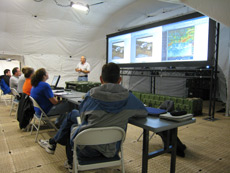PHOTO ALBUM
 BALDWIN COUNTY, AL - On May 3-8, agencies across Alabama came together to test their interoperable communication capabilities at the Alabama Communications Event, an exercise organized by the state’s Department of Homeland Security (AL DHS).
BALDWIN COUNTY, AL - On May 3-8, agencies across Alabama came together to test their interoperable communication capabilities at the Alabama Communications Event, an exercise organized by the state’s Department of Homeland Security (AL DHS).
During the four-day exercise, which was hosted by the Baldwin County Emergency Agency, various departments worked together to respond to a fictitious Category 5 hurricane that had wiped out all communication capabilities.
Responders, lacking a headquarters facility, also faced the challenge of handling the crisis solely from the field.
“Alabama recognizes that their state’s agencies need to be modular enough to respond to any type of situation,” explains DRASH Business Development Representative Mark Wlazlak, who was on hand for the exercise. “The event created a situation in which responders would have to work in an area where permanent structures were not available, or no longer existed.”
Nine regional communication response trucks owned by different agencies, as well as a Reeves Incident Command Post (ICP) Trailer were deployed throughout the event site to collect information at the scene. Once gathered, feeds of information were then transported to a DRASH Command Center nearby.
The DRASH Command Center, made up of a J Shelter and connecting MX and 4XB Shelters, featured a planning area, a fusion area in which responders sorted information from the field, and a central command area that served as a classroom and a space in which commanders could organize efforts.
The command area was also outfitted with a DRASH DC2E J Series Large Front Projection Display System. Using Virtual Alabama, a 3D visualization program, commanders were able to view multiple images from the scene, as well as track weather, on the display system.
“Having the display system was critical because it allowed our command staff to see exactly what was going on in the field in real time, helping them mitigate situations that would normally occur if we didn’t receive that kind of information from the scene,” says Alabama Department of Homeland Security interoperable communications coordinator Charles Murph, Jr. “And when you’re able to see everything going on on one screen, it really helps ensure that everyone is on the same page.”
Despite severe thunderstorms during much of the event, the AL DHS says that participating agencies were able to communicate with one another to successfully respond to the simulated hurricane.